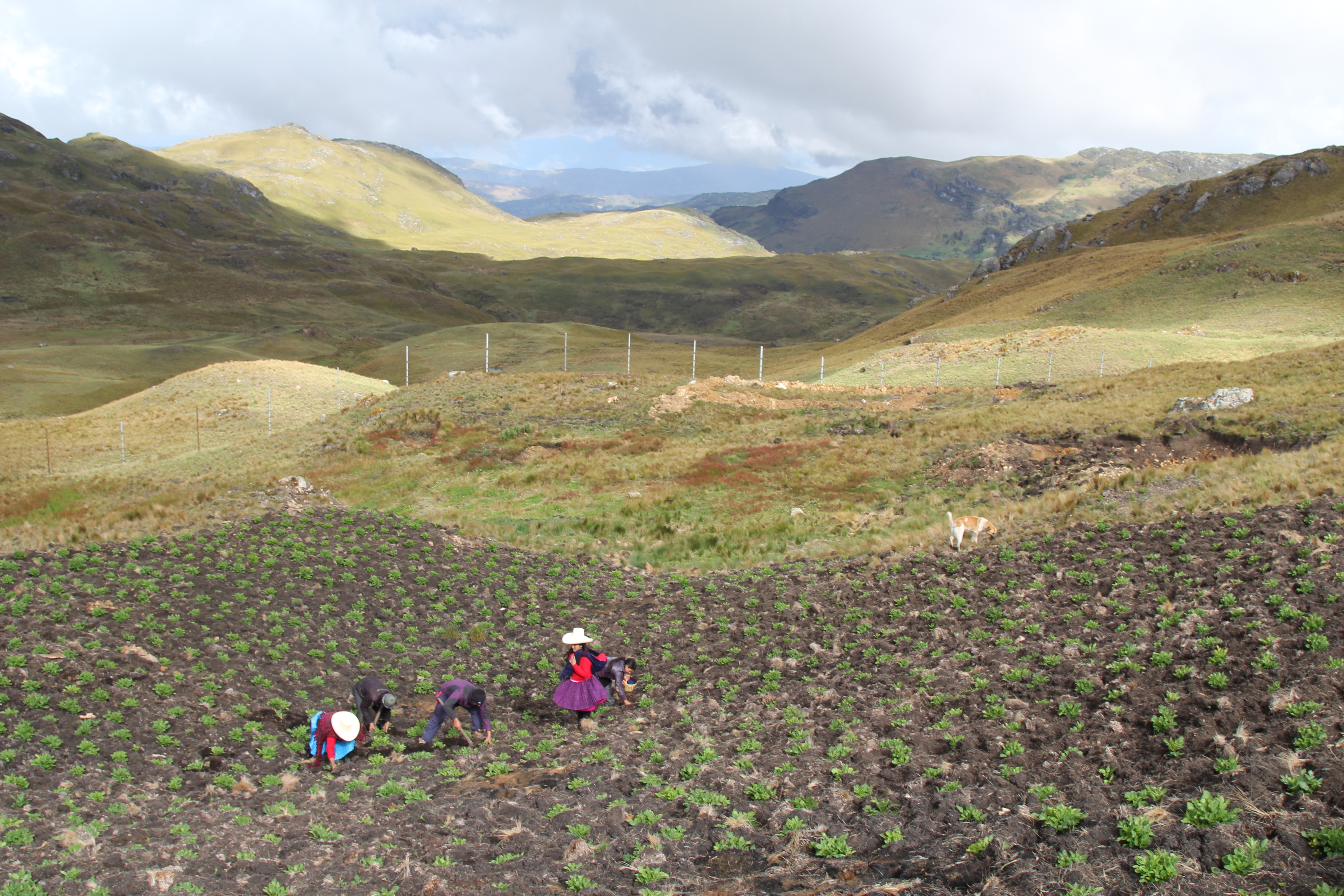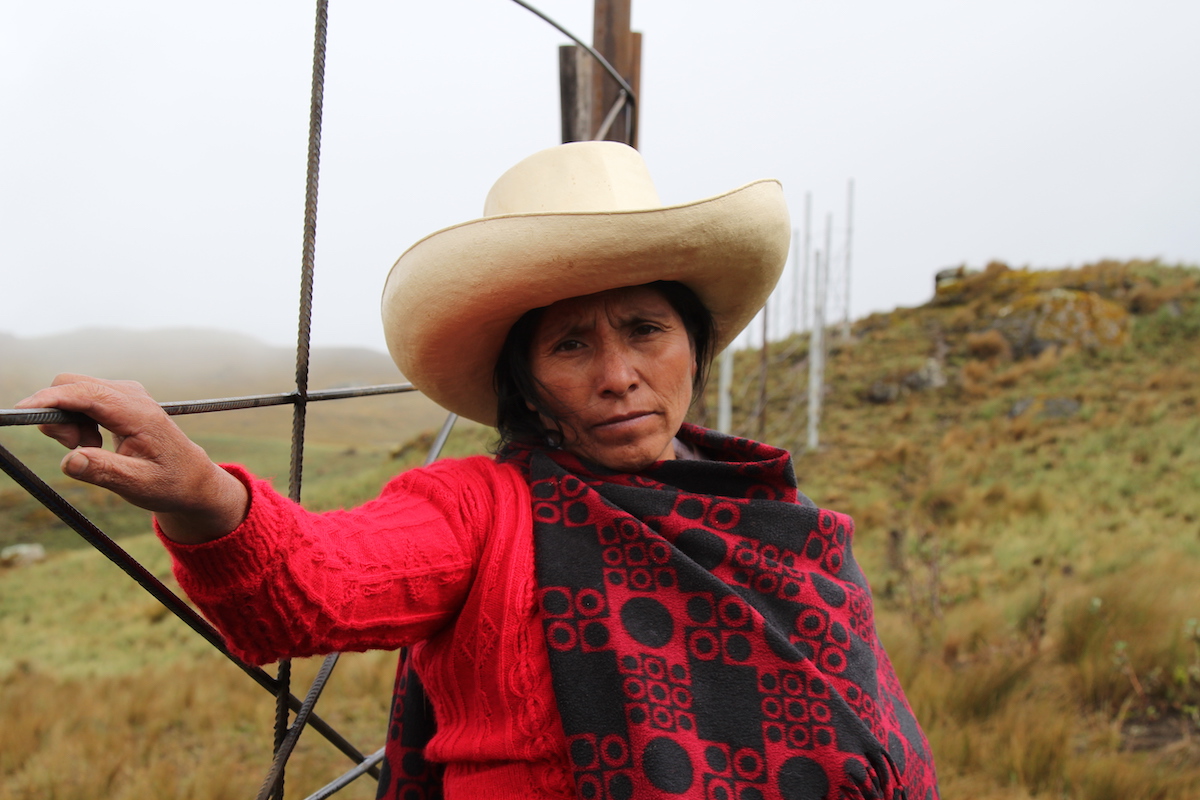(English Follows)
Una acción decidida vale más que mil palabras, como la de Máxima Acuña de Chaupe, una humilde agricultora peruana quien se ha convertido en el mayor obstáculo de una gran corporación multinacional.
Máxima siembra papas y verduras en un pueblito llamado Yanacocha cerca de Cajamarca, en el Perú, cerca de donde una corporación norteamericana de Colorado llamada Newmont explota una mina de oro al aire libre, la más grande de latinoamérica.
La industria minera en el Perú ha ido devorando todo a su paso durante los últimos años, apropiándose de tierras y envenenando las aguas. Las concesiones de explotación otorgadas por el gobierno ni siquiera han tomado en cuenta a los indígenas que viven en esas tierras.
La corporación Newmont y su socio local Minera Yanacocha expandieron sus operaciones hacia una mina de cobre llamada Conga. Pero esto implicaba destruir cuatro lagos de los cuales dependían las comunidades. La idea era drenarlos para excavar el mineral y uno de ellos, llamado Laguna Azul sería utilizado como pozo de almacenamiento de desechos tóxicos, amenazando las cabeceras de cinco cuencas y un humedal en el páramo de Cajamarca.
Pero Máxima les salió al paso y se convirtió en una piedra en sus zapatos. Un día en el 2011 la compañía minera tocó a su puerta y le dijo que tenía que marcharse, pues ellos eran los nuevos dueños de su tierra. Al negarse fue golpeada, al igual que una hija, y su casa y cultivos fueron arrasados por los guardias privados de la compañía minera.
Organizó protestas contra la mina Conga. Fue acusada y condenada a pagar $200 soles ($70 dólares), y cárcel por tres años si no abandonaba su tierra en 30 días. Todos los intentos legales de defenderse fueron denegados. Pero estas protestas llamaron la atención y le impidieron a Newmont operar la mina desde el 2012.
Pronto las protestas se extendieron hasta Lima y recibieron apoyo internacional.
El 5 de mayo de 2014, la Comisión Interamericana de Derechos Humanos (CIDH) de la Organización de Estados Americanos (OEA) solicitó al gobierno peruano que adoptase medidas cautelares de protección para Máxima, su familia y 46 líderes comunitarios, quienes habían sido amenazados de muerte.
“No temo al poder de las empresas, seguiré luchando”
— Máxima Acuña
En diciembre de 2014, la denuncia de cargos criminales de Newmont contra la familia Acuña fue desestimada, y en venganza sujetos desconocidos destruyeron los cimientos de la nueva casa de la familia Acuña. A Máxima le fue otorgado en el 2016 el premio Internacional Goldman Environmental Prize, el más importante del ambientalismo mundial.
La batalla legal entre Newmont Mining Company y la familia de Máxima continúa. Newmont intentó mantener la disputa en Perú, pero la reciente decisión de la Corte del Tercer Circuito de Lima significa un revés para Newmont pues Máxima y su familia continuarán luchando su caso ahora en los Estados Unidos.

Foto de Goldman Environmental Prize
A Rock Called Máxima Acuña
A determined action is worth a thousand words, such as Máxima Acuña de Chaupe, a humble Peruvian farmer who has become the biggest obstacle facing a large multinational mining corporation.
Maxima raises potatoes and vegetables in a small town called Yanacocha near Cajamarca, Peru, close to where a North American corporation called Newmont operates an open-air gold mine, the largest in Latin America.
The mining industry in Peru has been devouring everything in its path during the past several years, appropriating land and poisoning the waters. The exploitation concessions granted by the government have not even taken into account the Indigenous people who live on these lands.
The Newmont mining corporation and its local partner Minera Yanacocha expanded their operations to a copper mine called Conga. But this means destroying four lakes on which the communities depended. The idea was to drain them to excavate the ore, with one of them, called Laguna Azul, to be used as a storage pit for toxic waste, threatening the headwaters of five basins and a wetland in the Cajamarca moor.
But Máxima stepped out and became a stone in their shoes. One day in 2011, the mining company knocked on his door and told her that she had to leave, because they were the new owners of her land. When she refused, she was beaten, as was her daughter, and her house and crops were razed by the private guards of the mining company.
Máxima organized rallies against the Conga mine. She was charged and threatened with a fine of $200 soles ($70 dollars), and a three-year jail sentence if she did not leave her land in 30 days. All legal attempts to defend herself were denied. But these protests got attention and have prevented Newmont from operating the mine since 2012.
Soon the protests over her treatment extended to Lima and received international support.
On May 5, 2014, the Inter-American Commission on Human Rights of the Organization of American States requested that the Peruvian government adopt precautionary protection measures for Máxima, her family and 46 community leaders, who had been threatened with death.
“I don’t fear the power of corporations, I will keep fighting”
— Máxima Acuña
In December 2014, Newmont's criminal charges against the Acuña family were dismissed, and in revenge unknown persons destroyed the foundations of the new Acuña family home. In2016, Máxima was awarded the Goldman Environmental International Prize, the world's most prestigious environmental award.
The legal battle between Newmont Mining Company and Máxima's family continues. Although Newmont tried to keep the dispute in Peru, the recent decision of the Court of the Third Circuit of Lima was a setback for the company, as Máxima and her family can now continue to fight their case in the United States.
